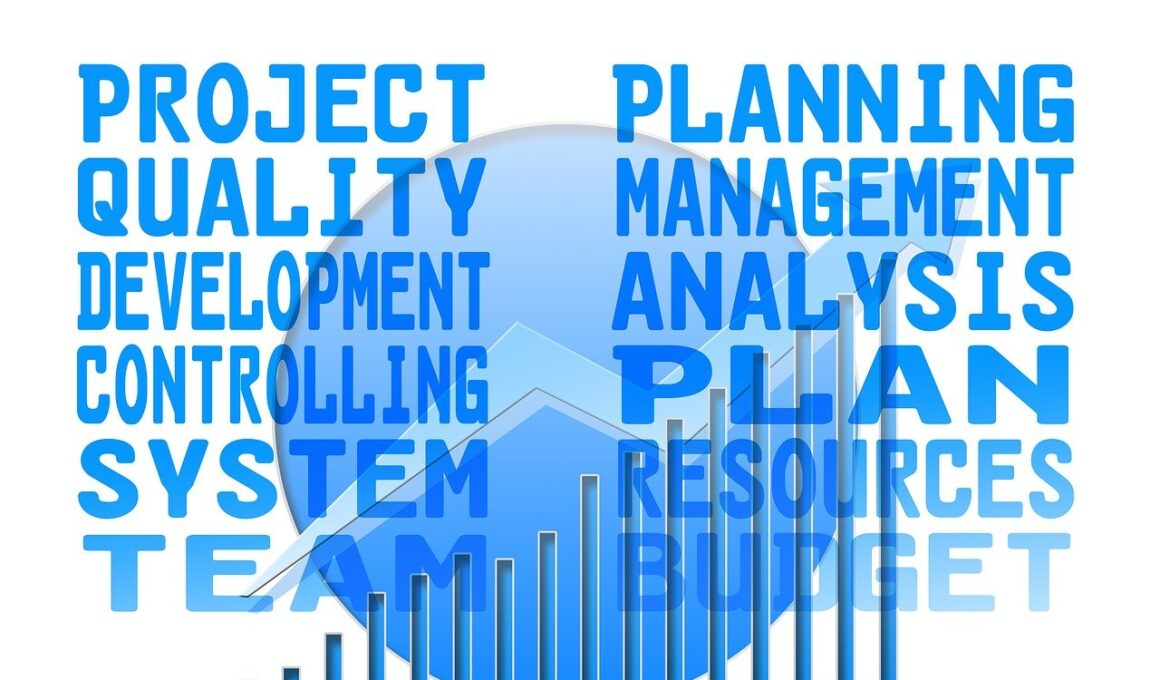The Role of Earned Value Management in Project Budget Oversight
Earned Value Management (EVM) serves as a crucial methodology for organizations involved in project management and budgeting. By integrating project scope, schedule, and costs, EVM provides a comprehensive framework that allows project managers to assess performance. It identifies discrepancies between planned and actual performance. Additionally, it enables organizations to forecast budgets and timelines more accurately. Therefore, EVM empowers managers to make informed decisions about resource allocation. Using concepts such as Planned Value (PV), Earned Value (EV), and Actual Cost (AC), EVM measures project performance against the original plan. As a result, it offers insights on project deviations, underscoring the importance of regular monitoring. Moreover, EVM can detect trends that may require intervention early on. This proactive approach caters to inherent uncertainties in projects, making project budgeting more reliable. In conclusion, integrating EVM into project oversight transforms the approach to budgeting variances, ultimately enhancing project success rates. Organizations that implement EVM can anticipate better control over projects and financial outcomes, reinforcing their overall project management strategy.
Understanding key concepts within Earned Value Management is essential for effective application. Planned Value (PV) represents the budgeted cost for the work scheduled to be completed by a specific time. Conversely, Earned Value (EV) signifies the budgeted cost of the actual work completed at that point. Finally, Actual Cost (AC) refers to the total costs incurred for the work completed by the same time. By comparing PV, EV, and AC, project managers gain insights into project performance. This data enables them to calculate critical metrics such as Cost Performance Index (CPI) and Schedule Performance Index (SPI). The CPI measures cost efficiency, while the SPI assesses schedule efficiency. These calculations provide a quantitative basis for evaluating a project’s health. A CPI greater than one indicates cost efficiency, whereas less than one signifies cost overruns. Similarly, an SPI greater than one shows the project is ahead of schedule. Managers can utilize these insights to make timely adjustments, whether reallocating resources or revising plans to improve performance. Consequently, mastering EVM and its core concepts ensures more effective project budget oversight.
Integrating Earned Value Management into the project lifecycle is vital for maintaining budget oversight. Organizations can proactively identify variances by adopting EVM during project initiation and planning phases. Early incorporation allows teams to establish baselines effectively and communicate expectations clearly. During the execution stage, continuous monitoring against these baselines is essential. Frequent analysis of EVM metrics enables prompt identification of discrepancies, fostering timely interventions. Feedback loops that incorporate this monitoring can lead to iterative improvements throughout the project lifecycle. Moreover, EVM encourages collaboration among team members by promoting transparency in performance assessments. When everyone understands the project objectives and current standing, accountability increases, aiding accountability. Team members are more motivated to report their progress accurately. Subsequently, this accurate reporting leads to better data for future projects since organizations can analyze past performance against EVM findings. Relying solely on traditional budgeting approaches often disregards the nuances of project progress. Hence, organizations that prioritize EVM find themselves better equipped to navigate uncertainties. In doing so, they are ultimately more capable of delivering projects on time and within budget.
Benefits of Using EVM for Project Budgeting
Adopting Earned Value Management in project budgeting brings several significant benefits. First and foremost, it empowers managers with precise performance metrics that help gauge actual progress. Improved visibility into project performance leads to better-informed decision-making. This responsive approach enables organizations to avoid detrimental budget overruns. Additionally, quantifying budget status with EVM facilitates effective communication among stakeholders, which is pivotal for project success. Transparent reporting helps establish trust, ensuring all parties are on the same page regarding project health. EVM’s predictive capabilities also deliver enhanced forecasting accuracy, allowing teams to anticipate future expenditures or delays efficiently. Consequently, project managers can engage in proactive planning rather than relying solely on reactive measures. Furthermore, using established EVM frameworks and templates can shorten training times and improve overall efficiency within project teams. Knowledgeable teams can swiftly adapt to EVM processes and produce consistent results. In turn, organizations yield greater returns on investment from their projects. Overall, the integration of EVM not only solidifies budget oversight but also enriches the overall project management experience.
Despite its numerous advantages, implementing Earned Value Management can be challenging. For instance, the initial setup requires a well-defined scope along with clear baselines for cost, schedule, and performance. Without these foundational elements, EVM calculations may yield inconsistent results. Moreover, organizations can face resistance to new methodologies, especially in environments where traditional approaches persist. Educating stakeholders about the benefits of EVM is critical to mitigating such resistance. Training sessions that emphasize the potential for improved project outcomes may encourage acceptance and facilitate smoother integration. Furthermore, project managers need to cultivate a culture of accountability and transparency. This cultural shift ensures team members understand the value of accurate performance reporting. However, organizations must also recognize that implementing EVM is not a replace-all strategy. Instead, EVM should complement existing project management techniques. Therefore, hybrid approaches that leverage EVM alongside other methodologies can enhance overall effectiveness. Ultimately, recognizing the challenges associated with EVM will allow organizations to strategize effectively, fostering an environment conducive to successful project budgeting.
Future Trends in EVM Utilization
As the landscape of project management continues to evolve, the utilization of Earned Value Management is likely to expand further. With the rise of technological advancements, such as Artificial Intelligence (AI) and Machine Learning (ML), integrating these tools can enhance EVM processes. For example, predictive analytics can be applied to EVM metrics to create more refined forecasts of project trends. Consequently, project managers can leverage real-time data to recognize potential issues before they escalate, improving decision-making efforts. Moreover, cloud-based platforms enable seamless collaboration among various project stakeholders, facilitating data sharing. This collaboration is anticipated to lead to streamlined reporting processes, allowing teams to maintain constant communication regarding project status. Additionally, industries are increasingly recognizing the need for efficient risk management strategies, which can be integrated into EVM frameworks. By aligning risk management within EVM, teams can better prepare for uncertainties that may impact budgets. As market demands evolve, adopting innovative tools and strategies within EVM will ensure organizations remain competitive. The future holds promising opportunities for organizations enhancing their project management capabilities.
In conclusion, Earned Value Management plays a vital role in project budget oversight, offering valuable insights to guide managerial decisions. Should organizations choose to adopt it effectively, the potential benefits can lead to enhanced project outcomes significantly. This methodology enhances project visibility and empowers project teams to make data-driven decisions. Through its distinct metrics, EVM allows stakeholders to identify trends over time and anticipate challenges. By emphasizing planning, monitoring, and forecasting, EVM helps project managers stay on track and within budget throughout the project lifecycle. Consequently, understanding EVM increases project stakeholders’ confidence and accountability, thus improving overall collaboration among all parties involved. Moreover, as industries shift towards digital transformation, EVM will continue to adapt and evolve alongside technological advancements. This evolution ensures that organizations remain well-prepared to tackle future challenges in project management and budgeting. Ultimately, integrating Earned Value Management establishes a robust foundation for successful project execution and financial management. In a world where budgets often dictate project feasibility, employing EVM may be the key to driving successful project outcomes consistently.
Through the exploration of Earned Value Management’s fundamental aspects, project managers can significantly enhance outcomes. The methodology not only provides accurate metrics but also encourages proactive decision-making. By iterating through lessons learned, organizations can continually improve their budgeting processes. Furthermore, the knowledge gained from the adoption of EVM can serve as a valuable resource in future projects. As project environments grow increasingly complex, the relevance of EVM will become more pronounced. Embracing its principles supports not only financial control but overall project success. Therefore, organizations that recognize the power of EVM in budgeting can position themselves for sustainable growth and excellence in all projects undertaken.


